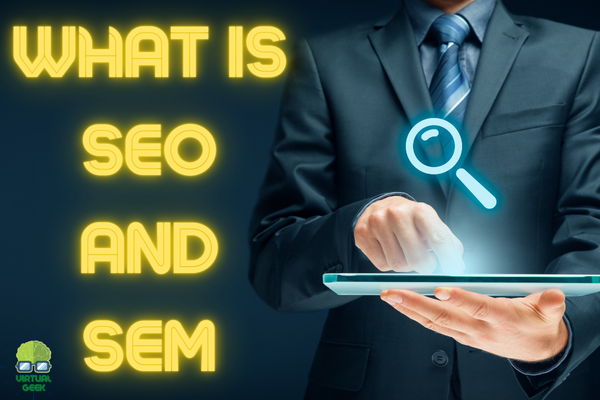Table of Contents
SEO and SEM are both digital marketing strategies used to improve visibility and organic traffic for a website. SEO (search engine optimization) is the process of improving the ranking of a website on search engine results pages (SERPs). SEM (search engine marketing) is the process of paying for ads and other forms of marketing to improve a website‘s visibility on SERPs.
Search Engine Optimization (SEO) is the practice of improving the ranking of a website on search engines. The higher the ranking, the more likely people are to find the website. SEM (Search Engine Marketing) is the process of marketing a website on search engines. The goal of SEM is to increase the visibility of a website and to improve its ranking on search engines.
SEO is the practice of optimizing a website for Google search with the goal of earning higher web traffic levels and improving the visibility of the site. SEM is the practice of marketing a website through paid Google ads with the goal of earning higher web traffic levels and improving the visibility of the site.

WHAT IS SEO
SEO is the process of optimizing a website for Google search with the goal of earning higher web traffic levels and improving the visibility of the site.
SEO covers both on-page factors (like titles, metatags, and keyword density) and off-page factors (like link popularity and anchor text).
SEO is important for any website that wants to earn higher search engine rankings and improve its visibility in Google search.
The first step in any SEO campaign is to understand the algorithms that Google uses to rank websites. These algorithms are constantly changing, which makes SEO a dynamic and ever-evolving field.
The second step is to identify the key areas of your website that need to be optimized for Google search. This includes both on-page and off-page factors.
On-page SEO factors include things like title tags, metatags, keyword density, and site structure. Off-page SEO factors include things like link popularity and anchor text.
The third step is to implement the changes necessary to improve your website’s SEO. This can be a complex and time-consuming process, depending on the size and scope of your website.
If you’re not familiar with SEO, it’s best to hire an experienced SEO consultant or agency to help you with this process.
SEO is an important part of any digital marketing campaign. By improving your website’s SEO, you can earn higher search engine rankings, improve your visibility in Google search, and drive more traffic to your website.
TYPES IS SEO
SEO is the process of optimizing a website for Google search with the goal of earning higher web traffic levels and improving the visibility of the site. There are a variety of different types of SEO, but the most common and effective types include on-page SEO, off-page SEO, and technical SEO.
On-page SEO refers to the optimization of individual web pages in order to rank higher in search engine results pages (SERPs). This type of SEO focuses on factors that are within the control of the website owner, such as the website content, website structure, and website design.
Off-page SEO, on the other hand, refers to the optimization of a website’s external factors, such as link building and social media engagement. This type of SEO is more difficult to control, but it can be just as effective as on-page SEO in terms of improving SERP rankings.
Technical SEO is a type of SEO that focuses on the technical aspects of a website, such as the website’s code, website speed, and website security. This type of SEO is often overlooked, but it is essential for ensuring that a website is accessible and visible to search engine crawlers.
All three of these types of SEO are important for earning higher SERP rankings. However, the most effective SEO strategy will often involve a combination of all three types.

WHAT ARE BLACK SEO AND WHITE SEO
Black SEO and White SEO are two terms used to describe different ways of optimizing a website for search engines. Black SEO generally refers to techniques that are used to improve a website’s ranking in search engine results pages (SERPs), but which may violate the search engine’s terms of service. White SEO, on the other hand, refers to techniques that are within the bounds of the search engine’s guidelines and which are unlikely to result in penalties.
There is no definitive list of techniques that can be classified as black SEO or white SEO, but some common examples of black hat SEO tactics include keyword stuffing, link buying, and cloaking. White hat SEO tactics, on the other hand, include things like optimizing for relevant keywords, building natural backlinks, and creating informative and keyword-rich content.
The choice of whether to use black hat or white hat SEO tactics is often a matter of debate, and there is no right or wrong answer. Some people believe that black hat SEO tactics can be effective in the short-term, but that they are not sustainable in the long-term. Others believe that white hat SEO tactics are the only way to go, even if they may take longer to produce results. Ultimately, the decision of which tactics to use is up to the individual website owner.
WHAT ARE BLACK SEO
What are black hat SEO techniques?
Black hat SEO is a term used to describe a set of practices that are used to get a site to rank higher in search engine results pages (SERPs), usually by violating search engine guidelines.
Some common black hat SEO techniques include:
- Keyword stuffing: This is the act of cramming a lot of keywords into your content in an attempt to fool search engines into thinking your site is relevant for those terms.
- Cloaking: This is when you show one version of your content to search engine bots and another version to users. The goal is to trick the bots into thinking your content is more relevant than it actually is.
- Link buying/selling: This is the practice of buying or selling links in order to artificially inflate your link popularity.
- Content scraping: This is when you copy content from other sources and post it on your own site.
- Doorway pages: These are pages that are designed solely for the purpose of getting users to click through to another page.
- Hidden text/links: This is when you hide text or links on your pages in an attempt to fool search engines into thinking they are not there.
- Spamming: This is the act of posting irrelevant or junk content on your site or on other sites in order to try and game the search engine algorithms.
These are just a few of the most common black hat SEO techniques. There are many others, and new ones are being created all the time.
Why are black hat SEO techniques bad?
There are a few reasons why using black hat SEO techniques is generally considered to be a bad idea.
For one, they go against search engine guidelines. This means that if you are caught using them, you could be penalized by the search engines, which could result in your site being removed from the SERPs entirely.
Additionally, black hat techniques are often used to try and game the system, which can result in a poor user experience. This is because black hat techniques are often used to trick users into clicking on things they don’t want to click on, or to see content that isn’t really relevant to their search.
Finally, black hat techniques are often not sustainable in the long run. This is because the search engines are constantly evolving and getting better at detecting and penalizing sites that use them. This means that if you use black hat techniques, it’s only a matter of time before your site is caught and penalized.
So, if you want to ensure that your site has a long and healthy life, it’s best to avoid black hat SEO techniques altogether.
WHAT ARE WHITE SEO
What are white SEO?
In simple terms, white SEO is the practice of optimizing a website for search engines with the goal of improving the site’s ranking in search engine results pages (SERPs).
The term “white hat SEO” refers to SEO tactics that are in line with the guidelines set forth by search engines like Google. White hat SEO is about improving the quality of a website with the goal of earning organic traffic from Google and other search engines.
White hat SEO tactics include things like creating high-quality content, optimizing website titles and descriptions, and building links from other websites.
Black hat SEO, on the other hand, refers to SEO tactics that are in violation of search engine guidelines. Black hat SEO is about gaming the system and trying to trick search engines into giving a website a higher ranking than it deserves.
Black hat SEO tactics include things like keyword stuffing, cloaking, and link buying. These tactics can get a website banned from Google and other search engines.
So, what are white SEO? White SEO is the practice of optimizing a website for search engines with the goal of improving the site’s ranking in search engine results pages. White hat SEO is about improving the quality of a website and following search engine guidelines.
WHAT IS SEM
SEM is short for Search Engine Marketing. It is a type of internet marketing that involves the promotion of websites by increasing their visibility in search engine results pages (SERPs) through the use of paid placement, contextual advertising, and paid inclusion.
SEM is a form of marketing that seeks to promote websites by increasing their visibility in search engine results pages (SERPs). The main aim of SEM is to improve the visibility of a website in order to attract potential visitors who are looking for relevant information through the use of key search engine marketing tools and techniques.

The most common SEM tools and techniques include:
- Pay per click (PPC) advertising: This is a form of online advertising where advertisers only pay when their ad is clicked by a potential customer.
- Contextual advertising: This involves the placement of ads on websites or in other online content that are relevant to the keywords that have been associated with the ad.
- Paid inclusion: This is a type of SEM where websites pay to have their pages included in the search engine results pages.
- Search engine optimization (SEO): This is a process of improving the visibility of a website in the organic or unpaid search results pages.
The main aim of SEM is to improve the visibility of a website in order to attract potential visitors who are looking for relevant information. However, SEM can also be used to target other objectives, such as increasing the number of sales or leads, or generating brand awareness.
SEM can be an effective way to achieve these objectives because it can target potential customers who are actively searching for information related to your products or services. In addition, SEM can be a cost-effective form of marketing, as you only pay when your ad is clicked by a potential customer.
If you are considering using SEM to promote your website, it is important to ensure that your website is optimised for search engines. This means that your website should be designed and structured in a way that makes it easy for search engines to find and index your content.
In addition, your website should contain relevant and keyword-rich content that is designed to attract the attention of potential customers. Once your website is optimised for search engines, you can then start to implement SEM techniques to improve your visibility in the search engine results pages.
WHAT ARE THE BENEFITS OF SEM AND WHICH TOOLS ARE USED SEM
SEM is short form for Search engine marketing. It is a process of marketing a website by means of increasing its visibility in search engine results pages (SERPs). The higher the visibility, the greater the chances of attracting potential customers to the website.
The main benefit of SEM is that it enables businesses to reach out to a wider audience, beyond their existing customer base. It also allows businesses to target their marketing efforts more precisely, by targeting specific keywords and phrases that are most likely to be used by potential customers when searching for the products or services that the business offers.
There are a number of different tools that can be used as part of a SEM campaign, including pay-per-click (PPC) advertising, search engine optimization (SEO), and social media marketing.
PPC advertising is a form of SEM in which businesses bid on keywords that they believe potential customers are likely to use when searching for their products or services. The business that bids the highest on a particular keyword gets their ad displayed in the sponsored results section at the top of the SERPs.
SEO is another form of SEM that involves optimizing a website for the purpose of improving its ranking in the organic (unpaid) results section of the SERPs. The main aim of SEO is to improve the visibility of a website in the organic results section by making it more relevant to the keywords that potential customers are likely to use when searching for the products or services that the business offers.
Social media marketing is also a form of SEM that can be used to improve the visibility of a website. Social media marketing involves creating and sharing content on social media platforms such as Facebook, Twitter, and LinkedIn, in order to promote the website and attract potential customers.
CONCLUSIONS ON THE ADVANTAGES AND BENEFITS OF SEO AND SEM
SEO and SEM are two of the most popular and effective digital marketing strategies used by businesses today. Both strategies can be used to increase traffic to a website, but they differ in how they work and what they aim to achieve.
SEO is a long-term strategy that focuses on improving a website’s organic search results. This is done by optimizing the website’s content and structure, as well as developing off-site SEO tactics like link building and social media engagement. SEO takes time to see results, but it can ultimately lead to more website visitors and higher conversion rates.
SEM, on the other hand, is a short-term strategy that focuses on paid advertising. This can be done through pay-per-click (PPC) ads, display ads, and other forms of paid marketing. SEM is typically used to drive immediate traffic to a website, and it can be an effective way to generate leads and sales.
Both SEO and SEM can be beneficial for businesses, but it’s important to choose the right strategy based on your goals. If you’re looking for long-term traffic growth, then SEO is the best option. If you need quick results and can afford to invest in paid advertising, then SEM may be the better choice.




